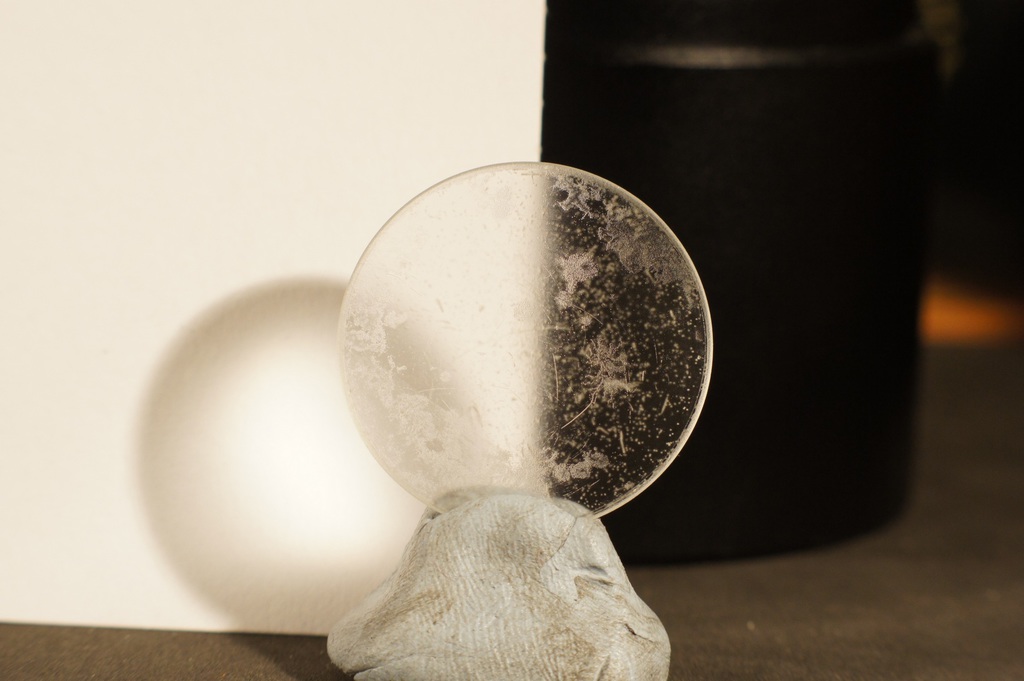| View previous topic :: View next topic |
| Author |
Message |
wayno

Joined: 08 Jun 2015
Posts: 52
Location: SE Indiana, USA
|
 Posted: Wed Jun 10, 2015 1:51 pm Post subject: Of fungus and lens coatings Posted: Wed Jun 10, 2015 1:51 pm Post subject: Of fungus and lens coatings |
 |
|
wayno wrote:
I understand that fungus contamination of a coated lens is of great concern because, even if the fungus is removed, it has likely caused irreversible damage to the lens coatings.
Is this just as true for older lenses as it is for newer lenses? I ask this question as a person not familiar with the evolution of coatings, as they have been applied to lenses, through the years. I assume that some lenses produced in the 1950s included coatings that delivered no great results, or, included no coatings at all. In such cases, would damage to the coatings be less of a consideration in putting older lenses back into service after fungus has been removed?
Thanks for any help with this. |
|
| Back to top |
|
 |
marcusBMG

Joined: 07 Dec 2012
Posts: 1314
Location: Conwy N Wales
|
 Posted: Wed Jun 10, 2015 2:38 pm Post subject: Posted: Wed Jun 10, 2015 2:38 pm Post subject: |
 |
|
marcusBMG wrote:
I've cleaned fungus off a good number of lenses now. In the majority of cases the fungus came off easily (I use a drop or two of household mould and mildew remover in a bit of meths) there was no visible deterioration of the lens surface/coating. In a couple of cases I could still see a residual mark where the fungus was - but I could not tell if this had any effect on IQ. IMO coating loss has to be extensive before there is a significant effect (tho it depends on which/how many elements are affected).
_________________
pentax ME super (retired)
Pentax K3-ii; pentax K-S2; Samsung NX 20; Lumix G1 + adapters;
Adaptall collection (proliferating!) inc 200-500mm 31A, 300mm f2.8, 400mm f4.
Primes: takumar 55mm; smc 28mm, 50mm; kino/komine 28mm f2's, helios 58mm, Tamron Nestar 400mm, novoflex 400mm, Vivitar 135mm close focus, 105mm macro; Jupiter 11A; CZJ 135mm.
A classic zoom or two: VS1 (komine), Kiron Zoomlock... |
|
| Back to top |
|
 |
berw
Joined: 20 Oct 2012
Posts: 38
|
 Posted: Wed Jun 10, 2015 4:23 pm Post subject: Posted: Wed Jun 10, 2015 4:23 pm Post subject: |
 |
|
berw wrote:
Well, this is how my orestor looks now, after removing the fungus:

And this is how it affects the image quality:
 |
|
| Back to top |
|
 |
tb_a


Joined: 26 Jan 2010
Posts: 3678
Location: Austria
Expire: 2019-08-28
|
 Posted: Wed Jun 10, 2015 5:09 pm Post subject: Posted: Wed Jun 10, 2015 5:09 pm Post subject: |
 |
|
tb_a wrote:
I would trade my Orestor without fungus for Grimbergen beer. The number of bottles would have to be negotiated. 
_________________
Thomas Bernardy
Manual focus lenses mainly from Minolta, Pentax, Voigtlaender, Leitz, Topcon and from Russia (too many to be listed here). |
|
| Back to top |
|
 |
berw
Joined: 20 Oct 2012
Posts: 38
|
 Posted: Wed Jun 10, 2015 6:14 pm Post subject: Posted: Wed Jun 10, 2015 6:14 pm Post subject: |
 |
|
berw wrote:
Now, that would be a good deal for both of us.  |
|
| Back to top |
|
 |
marcusBMG

Joined: 07 Dec 2012
Posts: 1314
Location: Conwy N Wales
|
 Posted: Wed Jun 10, 2015 7:00 pm Post subject: Posted: Wed Jun 10, 2015 7:00 pm Post subject: |
 |
|
marcusBMG wrote:
| berw wrote: |
Well, this is how my orestor looks now, after removing the fungus:
|
wow thats bad ass
_________________
pentax ME super (retired)
Pentax K3-ii; pentax K-S2; Samsung NX 20; Lumix G1 + adapters;
Adaptall collection (proliferating!) inc 200-500mm 31A, 300mm f2.8, 400mm f4.
Primes: takumar 55mm; smc 28mm, 50mm; kino/komine 28mm f2's, helios 58mm, Tamron Nestar 400mm, novoflex 400mm, Vivitar 135mm close focus, 105mm macro; Jupiter 11A; CZJ 135mm.
A classic zoom or two: VS1 (komine), Kiron Zoomlock... |
|
| Back to top |
|
 |
wayno

Joined: 08 Jun 2015
Posts: 52
Location: SE Indiana, USA
|
 Posted: Wed Jun 10, 2015 7:26 pm Post subject: Posted: Wed Jun 10, 2015 7:26 pm Post subject: |
 |
|
wayno wrote:
I am more of a Beck's man, myself. |
|
| Back to top |
|
 |
padam

Joined: 09 Oct 2012
Posts: 175
Location: Hungary
|
 Posted: Wed Jun 10, 2015 10:15 pm Post subject: Posted: Wed Jun 10, 2015 10:15 pm Post subject: |
 |
|
padam wrote:
It really depends on the lens and the amount of damage. If it is properly cleaned then it should not have much effect on the picture.
And later lenses generally have harder coatings then the earlier ones.
From my experience, haze/fogging can be more of an issue (if it is in a 'late' state) |
|
| Back to top |
|
 |
Ray Parkhurst


Joined: 04 Jul 2011
Posts: 504
Location: Santa Clara, CA, USA
|
 Posted: Thu Jun 11, 2015 2:12 am Post subject: Posted: Thu Jun 11, 2015 2:12 am Post subject: |
 |
|
Ray Parkhurst wrote:
Fungus doesn't actually eat the lens coatings, but it does deposit waste products of metabolism onto them and it is these acidic products that can damage the coating. Some coatings are much more resistant than others, and some fungal species are more effusive than others, so it is a roll of the dice as to how much damage they can cause on a particular lens. I've found that all species I have encountered are very hydrophilic, so come off very easily when hydrated. Breathing heavily onto the surface will nicely hydrate them, and keeping them hydrated for a minute or two seems to loosen their hold on the surface, making them easy to remove. However, in several cases I found the fungal "bodies" have very hard parts that can scratch the coatings, so be extremely careful not to push the fungal bodies around on the surface of the lens or you may end up with deep cleaning scratches. |
|
| Back to top |
|
 |
Lloydy


Joined: 02 Sep 2009
Posts: 7787
Location: Ironbridge. UK.
Expire: 2022-01-01
|
 Posted: Thu Jun 11, 2015 9:06 am Post subject: Posted: Thu Jun 11, 2015 9:06 am Post subject: |
 |
|
Lloydy wrote:
This is the result of fungus etching, the surface has been eaten away and rough enough to feel with my fingertips. This is an extremely affected lens, and sadly it was the only element in the lens affected in any way - all the other glass was spotless.

_________________
LENSES & CAMERAS FOR SALE.....
I have loads of stuff that I have to get rid of, if you see me commenting about something I have got and you want one, ask me.
My Flickr https://www.flickr.com/photos/mudplugga/
My ipernity -
http://www.ipernity.com/home/294337 |
|
| Back to top |
|
 |
quidam


Joined: 28 Sep 2012
Posts: 223
Location: Belgium
|
 Posted: Thu Jun 11, 2015 9:49 am Post subject: Posted: Thu Jun 11, 2015 9:49 am Post subject: |
 |
|
quidam wrote:
| Lloydy wrote: |
| This is the result of fungus etching, the surface has been eaten away and rough enough to feel with my fingertips. This is an extremely affected lens, and sadly it was the only element in the lens affected in any way - all the other glass was spotless. |
Which means that fungus isn't contagious for other lenses?
_________________
Sony Nex 5 & 6, Sony A7II. |
|
| Back to top |
|
 |
Lloydy


Joined: 02 Sep 2009
Posts: 7787
Location: Ironbridge. UK.
Expire: 2022-01-01
|
 Posted: Thu Jun 11, 2015 10:53 am Post subject: Posted: Thu Jun 11, 2015 10:53 am Post subject: |
 |
|
Lloydy wrote:
I certainly don't believe that fungus is infective from one lens to another. The information that I believe is - the fungus that affects lenses is fairly common and is not specific to glass or lenses, the spores are airborne and therefore everywhere. The key to avoiding fungus is not providing an environment where it can grow - fungus needs moisture / humidity and the dark. I have a few fungused lenses and store them with all my others without the lens caps to allow daylight to enter, in translucent plastic storage boxes. I control the humidity of the room to about 40% to 50%, sometimes it gets to 60% because my dehumidifier is a small one. I've never had a lens that's got worse, or got a fresh infection
_________________
LENSES & CAMERAS FOR SALE.....
I have loads of stuff that I have to get rid of, if you see me commenting about something I have got and you want one, ask me.
My Flickr https://www.flickr.com/photos/mudplugga/
My ipernity -
http://www.ipernity.com/home/294337 |
|
| Back to top |
|
 |
Ray Parkhurst


Joined: 04 Jul 2011
Posts: 504
Location: Santa Clara, CA, USA
|
 Posted: Thu Jun 11, 2015 1:05 pm Post subject: Posted: Thu Jun 11, 2015 1:05 pm Post subject: |
 |
|
Ray Parkhurst wrote:
| Lloydy wrote: |
| I certainly don't believe that fungus is infective from one lens to another. The information that I believe is - the fungus that affects lenses is fairly common and is not specific to glass or lenses, the spores are airborne and therefore everywhere. The key to avoiding fungus is not providing an environment where it can grow - fungus needs moisture / humidity and the dark. I have a few fungused lenses and store them with all my others without the lens caps to allow daylight to enter, in translucent plastic storage boxes. I control the humidity of the room to about 40% to 50%, sometimes it gets to 60% because my dehumidifier is a small one. I've never had a lens that's got worse, or got a fresh infection |
Fungus also needs food. The balsam glue between elements lenses seems to provide sustenance, and so do particles of dust. My theory is that a clean lens is a fungus-free lens. Clean and dry. |
|
| Back to top |
|
 |
Gardener

Joined: 22 Sep 2013
Posts: 950
Location: USA
|
 Posted: Thu Jun 11, 2015 2:33 pm Post subject: Posted: Thu Jun 11, 2015 2:33 pm Post subject: |
 |
|
Gardener wrote:
There are some brands that handle it better than others. In my experience older Rokkors coatings easily get damaged, and so do some Nikkors, yet Takumars seem to shrug off even major growth. |
|
| Back to top |
|
 |
wayno

Joined: 08 Jun 2015
Posts: 52
Location: SE Indiana, USA
|
 Posted: Thu Jun 11, 2015 10:18 pm Post subject: Posted: Thu Jun 11, 2015 10:18 pm Post subject: |
 |
|
wayno wrote:
Lloydy
Thank you for the photograph of the severely fungus etched lens. I would have never imagined fungus would damage the glass itself. I was always under the impression the damage would be limited to coatings. Very sobering.
Before undertaking the task of cleaning this lens, did you have any idea that the end result would be so bad? IOW, having now had this experience, are you better able to determine when it is worth cleaning fungus off of a lens,? as opposed to just taking a pass on a fungus damaged lens?
Best regards, |
|
| Back to top |
|
 |
CBokeh

Joined: 15 Oct 2009
Posts: 147
Location: Southern California
|
 Posted: Thu Jun 11, 2015 11:01 pm Post subject: Posted: Thu Jun 11, 2015 11:01 pm Post subject: |
 |
|
CBokeh wrote:
It looks like the Moon!
berw, I'm pretty sure that the fungus damage in your Orester will show up in circles of confusion (out of focus points of light). You'll have some gritty bokeh.
| Lloydy wrote: |
 |
|
|
| Back to top |
|
 |
Lloydy


Joined: 02 Sep 2009
Posts: 7787
Location: Ironbridge. UK.
Expire: 2022-01-01
|
 Posted: Fri Jun 12, 2015 10:34 am Post subject: Posted: Fri Jun 12, 2015 10:34 am Post subject: |
 |
|
Lloydy wrote:
That lens was the rear element of a Minolta Rokkor 135 3.5 which was unusable, the pictures were just a blurred mess, you couldn't even identify what the image was meant to be. I cleaned the fungus off the element with cold cream hoping that would save the lens, but the etching was just as damaging and far too deep to rescue by any amateur attempt at polishing the lens. The pictures were actually worse when I had removed the fungus, I think there was more diffraction ?
I try to avoid buying fungused lenses, but when it's a nice lens and cheap I might, and I do buy kits from charity shops that might have one bad lens. I think it's a difficult judgement about just how much there is and how much it will affect the image, I have a Vivitar 135 that is possibly 20% covered on an internal element that still takes decent pictures, that Rokkor was probably 100% covered. I've got a perfect Vivitar, I should compare them.
_________________
LENSES & CAMERAS FOR SALE.....
I have loads of stuff that I have to get rid of, if you see me commenting about something I have got and you want one, ask me.
My Flickr https://www.flickr.com/photos/mudplugga/
My ipernity -
http://www.ipernity.com/home/294337 |
|
| Back to top |
|
 |
Lloydy


Joined: 02 Sep 2009
Posts: 7787
Location: Ironbridge. UK.
Expire: 2022-01-01
|
 Posted: Fri Jun 12, 2015 4:01 pm Post subject: Posted: Fri Jun 12, 2015 4:01 pm Post subject: |
 |
|
Lloydy wrote:
I just tried the two Vivitar 135 2.8 lenses, both Komine, both in excellent condition but the Pentax PK mount lens has some fungus on a rear internal element. It's not bad, just around the edge. The Canon FD is just about unused. ( and for sale )
Both shot wide open, ISO 500, on a tripod, in the rain. I can't see any degradation of image in any picture at any aperture


_________________
LENSES & CAMERAS FOR SALE.....
I have loads of stuff that I have to get rid of, if you see me commenting about something I have got and you want one, ask me.
My Flickr https://www.flickr.com/photos/mudplugga/
My ipernity -
http://www.ipernity.com/home/294337 |
|
| Back to top |
|
 |
|
|
|
You cannot post new topics in this forum
You cannot reply to topics in this forum
You cannot edit your posts in this forum
You cannot delete your posts in this forum
You cannot vote in polls in this forum
|
